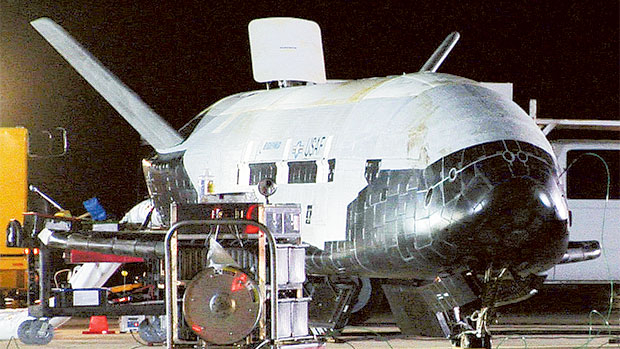
NEW YORK: It arrived back at a California airbase after dark. Only the eagle-eyed would have spotted the snub-nosed spacecraft gliding out of the black sky late on Friday night.
Officially, the unmanned Boeing-built X-37B Orbital Test Vehicle had just completed its longest ever mission, spending almost two years circling the Earth, conducting experiments for the US military.
But its secretive history has sparked countless theories about what the computer-controlled craft was really doing in space.
The Air Force has said little about the purpose of the robotic space plane, which has been paid for through the Pentagon’s veiled “black” budget.
“It’s all very hush-hush,” said Diana Ball, a spokeswoman for Boeing, which developed the plane for the US government at its Phantom Works research facilities in Huntington Beach.
The plane, which looks like a miniature space shuttle, was launched atop an Atlas V booster from Cape Canaveral in Florida on December 11, 2012.
One idea is that the US Air Force has developed a drone spy ship, which it uses to shadow Chinese satellites.
Another more fanciful claim is that it has been developed to engage in “sat-napping” — targeting rival spy satellites.
But Brian Weeden, a former officer for the Air Force’s space operations, said it’s more likely that the plane has been serving some function as an orbital spy.
He said the secrecy surrounding the mission suggests that it was doing work for the National Reconnaissance Office, which is in charge of the nation’s intelligence-gathering satellites.
“We can’t tell for certain what specific countries were the focus of its collections,” said Weeden, who is now technical adviser to the Secure World Foundation, “but we can deduce a few things from the orbit.”
He said that based on the plane’s path, it could have been collecting information from the Middle East, Afghanistan, Africa, Southeast Asia and Latin America.
Russia would not be included, he said.
There were few clues in an official press release. “The landing of OTV-3 marks a hallmark event,” said an unidentified programme manager quoted in the Air Force statement. “The mission is our longest to date and we’re pleased with the incremental progress we’ve seen in our testing of the reusable space plane.”
The first of the X-37B spaceplanes flew in April 2010 and returned after eight months. A second mission followed a year later. The next flight is planned for 2015.
At nine metres long, it is smaller than the retired Space Shuttle but shares a similar shape. It is thought to carry only a control system and fuel for its thrusters, leaving a cavity roughly the size of a truck bed.
The project started with Nasa before being handed to the military seven years later amid great secrecy, heightening speculation about its purpose.
Iran has described it as America’s space warplane, speculating that it is a version of the Predator drone adapted to fly beyond Earth’s atmosphere. But the USAF insists it was never designed to carry weapons.
On a previous mission, amateur space trackers spotted that its path mirrored that of China’s space lab, named Tiangong 1.
But so long as the space shuttle remains shrouded in secrecy, no one will ever be certain about its purpose.
— With inputs from agencies












